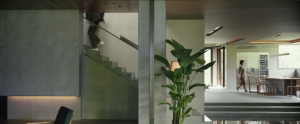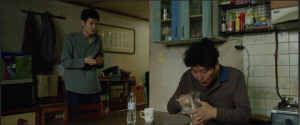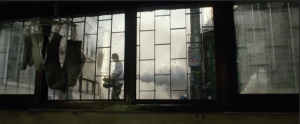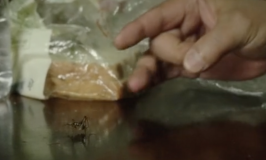PARASITE, DIR. BONG JOON-HO (2019)
Semi-basement, classic residential building style in Korea
Parasite is a movie directed by Bong Joon-ho. This movie tells the story of what happened between Kim Ki-taek’s family and Park’s family. Due to the failure of business and unemployment, Kim Ki-taek’s family has to live in a basement with low rent. In contrast, the Park family is very wealthy. As the Park daughter’s original tutor, a close friend of the Kim son, needs to study abroad, the Kim son got the opportunity to be the tutor of the Park daughter, and the four members of the Kim family are able to find jobs with the Park family and started a new life just like parasite.

Kim family’s house

Kim family’s house
The main social issue that this movie discussed is the gap between the rich and the poor: the poor living conditions of the people at the bottom vs the luxury life of the upper classes. The environment in which the protagonist’s family lives is the most direct reflection of this social situation. The structure of the family’s home is a “semi-basement” structure which can be found in many Korean buildings. Since the Korean government does not allow renting out basements for people to live in, many estate developers choose to build semi-basements to provide the most basic living environment for the lower class of society. This “semi-basement” style of house is not completely sealed from the sun like the basements of ordinary residential buildings but has half of the house above the ground level, which allows space for windows at the top of the room and ensures that a small portion of sunlight can enter the room. At the same time, due to the low-lying terrain, these basements often face serious dampness, mold, and other problems. The portrayal of these basements in the film truly illustrates the hardships and pressures faced by the lower class in Korean society, and contrasts with the mansions where the Kim’s family live, showing the two entirely different living conditions of Koreans in the post-financial crisis and the monopoly of large conglomerates and corporations. In terms of the presentation of the film, the film shows the two different living conditions of Koreans in the post-financial crisis and the monopoly of large conglomerates and corporations.
 Semi-basement in Korea¹
Semi-basement in Korea¹
In terms of the presentation of the film, the scenes in the film are suggestive of the characters’ state of mind. For example, the father in the film loves the only small window in the house, and although there is no beautiful scenery outside the street, only cars and pedestrians, the father in the film often stands in front of the window looking into the distance and enjoying the subtle sunlight. This is a metaphor for the fact that although the family is in a difficult environment, they still have some hope for their future life. However, this ray of light is often disturbed by drunken people, and also by sprayed insecticide, All this tells them that they are insects that are hated in society like “camel cricket²”. And all this for their living environment rendering also makes them throughout the film psychological inferiority which led to the final conflict of the film and made the story end in tragedy.

Window of the semi-basement and cleaning staff spray insecticide outside

Kim Ki-taek is flicking a camel cricket off the table
– ZHU Yifan Gary 3035937886
NOTES:
1: DAISUKE SHIMIZU, (2020), Oscar-winning ‘Parasite’ reflects life of basement tenants in Seoul, The Asahi Shimbun. https://www.asahi.com/ajw/articles/13116404
2: Camel cricket is a kind of common insect in South Korea, it like humidity and it is hard to killed.
I appreciate how you provided more context for the ‘semi-basement’ style of housing and pointed out some specific details of how the space could be experienced in reality. In exploring the contrast between the two families’ houses and the connection between the space and the Kim family’s psychology, you can also try to analyse the scenes in terms of the visual techniques used. Overall, there seems to be limited field trip materials, which limits the specificity and visual aspect of your comparative analysis.